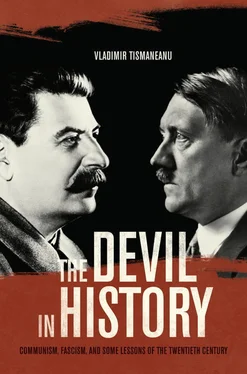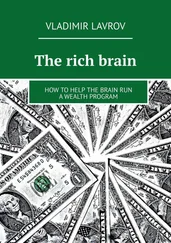25. I am paraphrasing here Mary Fulbrook’s theory of the “octopus” state (in counterdistinction to the pyramidal conceptualization of the Soviet-type regimes). See Mary Fulbrook, “Reckoning with the Past: Heroes, Victims, and Villains in the History of the German Democratic Republic,” in Rewriting the German Past—History and Identity in the New Germany , ed. Reinhard Alter and Peter Monteath (Atlantic Highlands, N.J.: Humanities Press, 1997), pp. 175-96; Mary Fulbrook, The People’s State: East German Society from Hitler to Honecker (New Haven, Conn., and London: Yale University Press, 2005).
26. Quoted in François Furet, The Passing of an Illusion: The Idea of Communism in the Twentieth Century , trans. Deborah Furet (Chicago: University of Chicago Press, 1999), p. 541.
27. E. A. Rees, “The Sovietization of Eastern Europe,” in The Sovietization of Eastern Europe: New Perspectives on the Postwar Period , ed. Balázs Apor, Péter Apor, and E. A. Rees (Washington, D.C.: New Academia Publishing, 2008), p. 13.
28. Kenneth Jowitt, New World Disorder: The Leninist Extinction (Berkeley and Los Angeles: University of California Press, 1992), pp. 1-12.
29. Norman Cohn, The Pursuit of the Millennium: Revolutionary Messianism in Medieval and Reformation Europe and Its Bearing on Modern Totalitarian Movements (New York: Harper and Row, 1961); Arthur Koestler, The Invisible Writing (London: Macmillan, 1969).
30. Aleksander Wat, My Century , foreword by Czesław Miłosz (New York: New York Review of Books, 1988), p. 92.
31. Georg Lukács, The Destruction of Reason (Atlantic Highlands, N.J.: Humanities Press International, 1981). On Lukács, see Leszek Kołakowski, Main Currents of Marxism: The Founders, the Golden Age, the Breakdown , trans. P. S. Falla (New York: W. W. Norton, 2005), pp. 989-1032. It remains disturbing that Lukács’s abdications between 1929 and 1953 have been leniently treated by authors who seem less inclined to forget Heidegger’s no less outrageous idyll with National Socialism.
32. Jochen Hellbeck, “Fashioning the Stalinist Soul,” in Stalinism: New Directions , ed. Sheila Fitzpatrick (London and New York: Routledge, 2000), p. 111. Also see “Working, Struggling, Becoming: Stalin-Era Autobiographical Texts,” Russian Review , no. 60 (July 2001): 340-59.
33. Jochen Hellbeck, Revolution on My Mind: Writing a Diary under Stalin (Cambridge: Harvard University Press, 2006), pp. 13-14. See also Igal Halfin, “Good and Evil in Communism,” in Terror in My Soul: Communist Autobiographies on Trial (Cambridge, Mass.: Harvard University Press, 2003). This subjective identification of victims with the system was very different in Nazi Germany, where a diarist like Victor Klemperer maintained a wounded lucidity. See Victor Klemperer, I Will Bear Witness: A Diary of Nazi Years, 1933-1941 (New York: Random House, 1998); and I Will Bear Witness: A Diary of the Nazi Years, 1942-1945 (New York: Random House, 1999).
34. Ferenc Fehér and Agnes Heller, Eastern Left, Western Left: Totalitarianism, Freedom, and Democracy (Atlantic Highlands, N.J.: Humanities Press International, 1987), pp. 265-66.
35. Alvin W. Gouldner, Against Fragmentation: The Origins of Marxism and the Sociology of Intellectuals (New York: Oxford University Press, 1985), pp. 260-61.
36. See the two volumes of Koestler’s memoirs: Arthur Koestler, Arrow in the Blue (New York and London: Macmillan Collins, 1952); and The Invisible Writing: The Second Volume of an Autobiography: 1932-40 (New York: Macmillan, 1954).
37. Tucker, The Soviet Political Mind , pp. 31 and 36.
38. Cohen, Bukharin , p. 268.
39. Ivan Margolius, Reflections of Prague: Journeys through the Twentieth Century (London: Wiley, 2006), p. 153.
40. Ibid., p. 193.
41. Ibid., pp. 220-21.
42. Ibid., pp. 226-27. See also Eugen Loebl, My Mind on Trial (New York and London: Harcourt Brace Jovanich, 1976).
43. Branko Lazitch in collaboration with Milorad M. Drachkovitch, Biographical Dictionary of the Comintern (Stanford, Calif.: Hoover Institution Press, 1986), p. 135.
44. Jorge Semprun, Communsim in Spain in the Franco Era: The Autobiography of Federico Sánchez (Brighton: Harvester Press, 1979), pp. 3-22.
45. For reasons of space, I cannot dwell in this chapter as much as I would wish on other similar frame-ups in Eastern Europe. I want to emphasize that there were cases in which the defendants (Communists or non-Communists) resisted psychological and physical torture and refused to endorse the Stalinist scripts through their confessions. Zavis Kálándra, mentioned in one of the epigraphs of this chapter, was a Czech surrealist poet who condemned the Moscow show trials, engaged in anti-Fascist resistance, and spent the war years in concentration camps. In 1950, he was a codefendant, together with democratic politician Milada Horáková, in a spectacular trial. The trial was a failure because most of the defendants challenged the prosecution. In spite of international pressures, including appeals from Albert Einstein, Eleanor Roosevelt, Winston Churchill, and André Breton, Kálándra, Horáková, and the others were sentenced to death and hanged.
46. Cohen, Bukharin , p. 227.
47. Max Horkheimer, Dawn and Decline (New York: Seabury Press, 1978), p. 239.
48. Hannah Arendt, The Life of the Mind (San Diego and New York: Harcourt Brace Jovanovich, 1978), p. 45.
49. Tucker, The Soviet Political Mind , pp. 40-41.
50. James G. Williams, ed., The Girard Reader (New York: Crossroad Publishing, 1996), p. 97-141. The same type of mechanism can be identified in the process of imagining the categories “saboteur” and “kulak” after 1929 in the USSR.
51. For the significance of this question in the Leninist mindset, see Martin Amis, Koba the Dread: Laughter and the Twenty Million (New York: Hyperion, 2002); Service, Lenin.
52. Cohen, Bukharin , p. 92.
53. Ibid., p. 91.
54. Riegel is paraphrasing here Yemelian Yaroslavsky, Bolshevik luminary and one of Stalin’s most trusted party historians. See Klaus-Georg Riegel, “Confessions of Sins within Virtuosi Communities,” in Parler de soi sous Staline: La construction identitaire dans le communism des années trente , ed. Brigitte Studer, Berthold Unfried, and Irène Hermann (Paris: Éditions de la Maison des Sciences de l’Homme, 2002), p. 116.
55. Igal Halfin, From Darkness to Light; Terror in My Soul: Communist Autobiographies on Trial (Cambridge, Mass.: Harvard University Press, 2003); Intimate Enemies: Demonizing the Bolshevik Opposition, 1918-1928 (Pittsburgh, Penn.: University of Pittsburgh Press, 2007). The mechanisms described by Halfin are “local” manifestations of a more general phenomenon that S. N. Eisenstadt defined as “the ideological sacralization of revolutionary terror” in his book Fundamentalism, Sectarianism, and Revolution: The Jacobin Dimension of Modernity (Cambridge: Cambridge University Press, 1999).
56. Peter Haidu, “The Dialectics of Unspeakability: Language, Silence, and the Narratives of Desubjectification,” in Probing the Limits of Representation—Nazism and the “Final Solution,” ed. Saul Friedlander (Cambridge, Mass., and London: Harvard University Press, 1992), p. 261.
57. Tucker, The Soviet Political Mind , pp. 68-69.
58. Philip Rahv, Essays on Literature and Politics, 1932-1972 (Boston: Houghton Mifflin, 1978), p. 288.
59. Zbigniew Brzezinski, “The Pattern of Political Purges,” in “The Satellites in Eastern Europe,” special issue, Annals of the American Academy of Political and Social Science 317 (May 1958): 79-87.
Читать дальше












